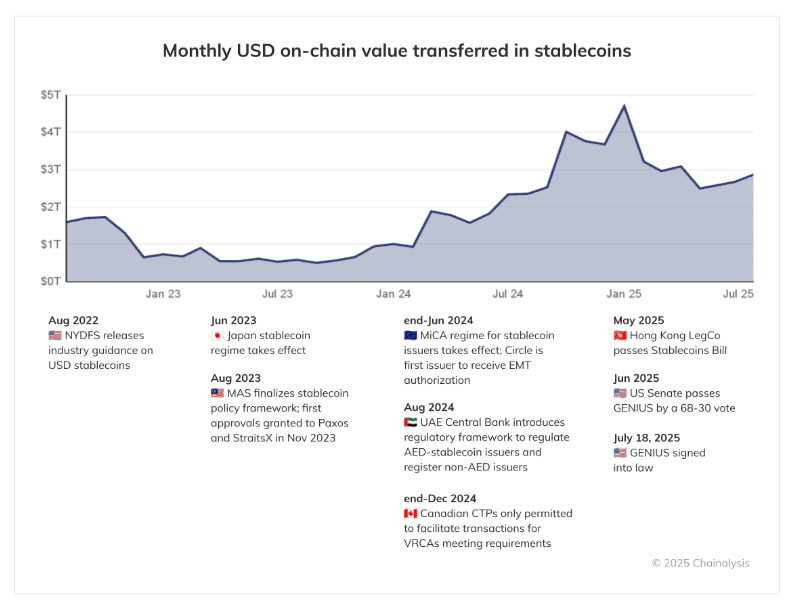
Stablecoins, designed to maintain a stable value against fiat currencies, are an increasingly important element in global digital payment systems.
Currently, at least 11 major jurisdictions have adopted specific regulatory frameworks for these digital currencies, a crucial factor in understanding how their use, security, and trust are managed in the contemporary financial market.
In your report “The Road to Crypto Regulation Part 2”Blockchain intelligence firm Chainalysis highlighted that this move toward stablecoins reflects the growing attention of governments, financial institutions, and businesses seeking to balance innovation and stability in an increasingly dynamic digital environment.
The capacity of send money quickly and without high costs It has been a constant desire in the financial world, and stablecoins have emerged as that innovative solution that can transform cross-border payments and financial settlements, making them more agile and economical than ever.
Create your account and manage stablecoins nowStablecoin regulation: balancing trust and global growth
Stablecoins have come a long way in a very short time. Although they began as a simple solution to facilitate the exchange of assets within the crypto universe, they have quickly transformed into a key driver of financial innovationThese digital currencies, which maintain a fixed value by being backed by traditional assets such as the dollar or the euro, have managed to overcome historical barriers in settlement and payment processes. Thanks to this, they have become an efficient and accessible tool for conducting digital transactions quickly and reliably.
According to data From Chainalysis to July 2025, eleven of the twenty-five most influential financial jurisdictions in the world are already moving decisively towards the creation of specific regulations for stablecoinsThis movement is especially notable in more developed economies, where traditional financial systems are seeking to integrate these new technologies within a clear regulatory framework.
According to the report, this integration not only boosts the confidence of large investors and institutions, but also creates an environment where users can operate with greater security.
11 jurisdictions leading stablecoin regulation in 2025
In 2025, the global stablecoin regulatory landscape is clearly dominated by a few regions that have made significant progress in creating a robust regulatory framework. North America, Europe and Asia lead with concrete rules that seek to regulate and protect the use of these digital currencies backed by real assets. However, many emerging economies are still in the exploration stage, lacking a defined regulatory framework for this technology.
Bit2Me: Trade regulated stablecoins with global trustAccording to the report, United States It stands out with its GENIUS Act, which stands as a benchmark for the regulation of dollar-backed stablecoins. In the United Kingdom, regulations have taken a firm course toward transparency and ensuring sufficient reserves, seeking greater market confidence. Japan, for its part, has integrated these currencies into its financial system, under strict custody rules that reinforce security.
No less important are Switzerland y Singapore, which combine an innovation-friendly approach with rigorous controls against money laundering and terrorist financing.
In Europe, MiCA regulation drives countries like France, German, Italy and Netherlands to consolidate themselves as territories with clear regulations for stablecoins. While in Asia, South Korea y Hong Kong They are committed to strategies that prioritize interoperability between systems and user protection.

This regulatory map It shows an inevitable trend: economies with more advanced financial infrastructure set the pace and establish the rules of the game in the stablecoin market, while many emerging regions observe and analyze these models, seeking to define their own course.
The current state of regulations creates a somewhat fragmented global environment, but it also highlights a growing consensus on the importance of these digital currencies to the global financial system. According to the Chainalysis study, these regulations not only seek to protect economic stability, but also to ensure transparency, adequate oversight, and reduce risks associated with fraud or misuse.
Thus, stablecoins have evolved from a disruptive experiment to a key component of financial infrastructure, driving the development of advanced financial products and facilitating large-scale digital payments.
Transfer, pay, and trade with regulated stablecoinsMiCA and the GENIUS Act: Europe and the US are redefining stablecoins
The regulation of stablecoins is taking a decisive path in Europe with the entry into force of the MiCA Regulation, a framework designed to harmonize and strengthen the digital asset ecosystem on the continent. This regulation not only establishes clear rules for issuers and service providers regarding cryptoassets, but also places special emphasis on transparency and user protection.
MiCA requires stablecoins to be backed by solid assets and managed with high standards of governance and oversight, seeking to avoid financial risks and foster public trust.
Meanwhile, across the Atlantic, the United States took a firm step this year with the approval of the GENIUS Act, the first formal crypto regulation in the country, which has been considered an international benchmark in stablecoin regulation. This law strictly defines issuers as regulated financial entities that must maintain liquid and auditable reserves to ensure market stability and confidence. Furthermore, it places these issuers under the strict supervision of the Bank Secrecy Act, reinforcing the prevention of illicit activities.
Both regulatory frameworks, MiCA in Europe and the GENIUS Act in the United States, represent the natural evolution of financial supervision in an increasingly digital world. On the one hand, they seek to provide legal certainty that promotes the orderly integration of these digital assets into traditional financial systems. On the other, they establish clear limits to avoid systemic risks and protect consumers.
Together, these laws mark a global standard that other regions are watching with interest and from which new forms of crypto regulation are beginning to take shape, where innovation meets responsibility.
Regulation redefines the future of stablecoins and digital payments
The regulation of stablecoins is marking a decisive shift in the way this industry and digital payments in general operate.
The Chainalysis study highlights that issuers that comply with new regulations are gaining an advantage in a market that increasingly demands greater security and institutional trust. Thus, far from hindering innovation, these regulations are creating fertile ground where technological creativity and regulatory compliance can advance hand in hand. All of this opens the door for stablecoins to be increasingly used in digital payment services, bank-to-bank transfers, and various financial products.
Furthermore, greater regulatory clarity in these jurisdictions is driving new strategic alliances between fintechs, traditional banks, and other financial sector players. The goal is to create more robust and accessible infrastructures for end users, making it easier for digital payments globally to rely on stable, regulated, and proven digital assets.
Create your account and transfer with reliable stablecoinsThe implementation of regulations such as MiCA and the GENIUS Act promise to revolutionize the competitive landscape, benefiting those who quickly adapt to these standards and promoting better connectivity with traditional financial systems.
Finally, these changes not only impact the local level, but also require much closer international coordination. With stablecoins gaining presence in global markets and operations, regulation becomes key to balancing security, transparency and trustIn other words, regulation and legal clarity open up a range of opportunities to innovate and accelerate the mass adoption of digital payments in an increasingly interconnected global economy.


